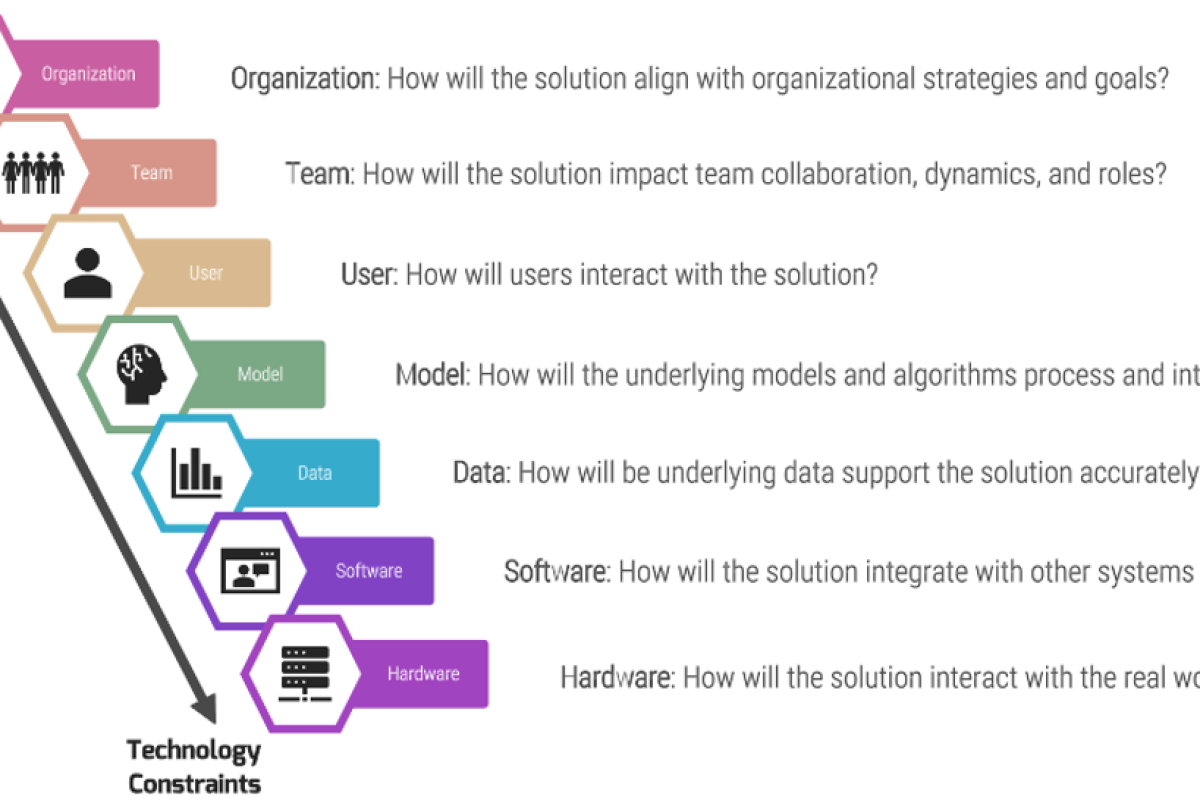Technological change is rarely a simple swap of old tools for new ones. Every innovation, whether a cloud migration, an AI deployment, or a new collaboration platform, ripples across multiple layers of an organization. The visual framework shown below, called the “Human-Tech Ladder“, was developed by a researcher at Info-Tech Research. It illustrates this reality: each rung represents a dimension where change will have impact, from hardware and software at the base to organizational strategy at the top.
Taken together, these dimensions remind us that change is not only technical. It is human, cultural, and strategic. Effective change management requires leaders to systematically examine how each dimension is affected. Neglect one, and even the most promising project risks falling short. Let’s explore each rung of the ladder, and how it shapes the success of technology-driven transformation.

Hardware: The Foundation of Interaction
At the base of the ladder sits hardware, the physical layer of technology. Servers, sensors, devices, and network equipment form the tangible infrastructure on which solutions run.
In change management terms, hardware decisions carry immediate operational consequences. An AI-powered analytics system may require new GPUs; a shift to remote work demands secure laptops and headsets; a robotics rollout calls for entirely new equipment on the factory floor.
The key challenge here is ensuring that hardware changes are not just procured but fully integrated into daily workflows. Training, maintenance planning, and supply chain considerations must be factored in. Leaders who treat hardware as “plug-and-play” often underestimate the degree of disruption caused by even small physical changes.
Software: Integration as a Success Factor
Above hardware lies software – the applications, platforms, and digital tools that enable business processes.
When organizations adopt new software, change management must address more than licensing and installation. It must tackle questions of integration: How will this software connect with existing systems? How will workflows shift? Which processes will become faster, and which may temporarily slow during the learning curve?
Software also introduces governance issues. Permissions, data access, and cybersecurity all shift when new platforms are deployed. A well-planned rollout includes pilot programs, phased adoption, and feedback loops to ensure that the technology integrates smoothly without overwhelming employees.
Data: The Lifeblood of Digital Systems
Climbing further, we encounter data, the raw material that fuels modern technology. Data is no longer a byproduct of operations—it is the currency of decision-making.
Change management in the data dimension means answering tough questions: How will data be collected, cleaned, and maintained? Who owns it? How will accuracy and consistency be ensured?
Consider a healthcare provider adopting a new patient portal. The software may be functional, but if patient records are riddled with errors or missing fields, the project will not achieve its intended impact. Successful leaders embed data governance into their change plan, establishing standards, accountability, and ongoing monitoring to ensure quality.
Model: Algorithms as Interpreters
Sitting atop data are the models – the algorithms, statistical methods, and AI systems that process and interpret information.
The shift from traditional systems to model-driven decision-making represents one of the most profound organizational changes of our time. Employees and leaders alike must trust models, understand their limitations, and adapt to workflows shaped by predictive insights.
Change management here involves transparency. Stakeholders need to know how models work, what assumptions they contain, and how results will be monitored for fairness and accuracy. Without this trust, adoption stalls. The human-tech ladder reminds us that even the most advanced algorithms cannot succeed if people resist their outputs.
User: The Human Experience of Technology
Next comes the user dimension – the point of direct interaction between humans and technology.
Change management here requires a user-centered lens: How intuitive is the interface? How will training be delivered? What support systems exist for those who struggle?
Resistance often concentrates at this level, because users experience change most directly. A poorly designed interface can sink adoption, no matter how advanced the underlying system. Leaders who invest in usability testing, clear onboarding, and responsive support dramatically improve the odds of success.
Team: Collaboration, Roles, and Dynamics
The team dimension considers how groups of people work together once technology is introduced.
Here, change management must account for shifts in collaboration and responsibility. A new CRM system, for example, might alter the balance between sales and marketing. A data-driven forecasting tool could change how finance and operations coordinate.
The challenge is not just technical training but cultural alignment. Teams must renegotiate workflows, decision rights, and performance expectations. Leaders must facilitate these conversations, ensuring that new technologies strengthen collaboration rather than create friction.
Organization: Strategy and Alignment
At the top of the ladder sits the organization dimension – the strategic layer where technology aligns with long-term goals.
This is the dimension most often overlooked when projects are driven solely by technical enthusiasm. Yet without clear organizational alignment, even the most sophisticated systems can flounder. The key questions here are: How does this solution advance our mission? How does it contribute to competitive advantage? How will it position us for future growth?
Change management at the organizational level requires executive sponsorship, communication of vision, and metrics that tie technology adoption directly to business outcomes. When employees see a clear link between the change and organizational success, they are more likely to embrace it.
A Ladder, Not a Checklist
The human-tech ladder is more than a list of considerations. It is a hierarchy of dimensions of the impact of Innovation, reminding us that change must be addressed from the ground up while keeping the human and organizational context at the forefront. Hardware and software set the stage, but success ultimately depends on how well people and strategies adapt at the higher rungs.
Change leaders who climb the ladder thoughtfully can anticipate resistance, allocate resources effectively, and design interventions that touch every dimension. Those who skip rungs risk undermining their efforts.
The Critical Role of Change Management
Innovation projects succeed or fail not just on technical merit but on how well change is managed across these dimensions. A brilliant algorithm without user trust is worthless. A seamless new platform without team alignment becomes a bottleneck. A powerful hardware upgrade without strategic clarity simply adds cost.
Change management, then, cannot be an afterthought! It is very often the difference between success and failure. By systematically reviewing each change through the lens of the human-tech ladder, leaders ensure that preparation matches ambition. Hardware is supported, software is integrated, data is governed, models are trusted, users are empowered, teams are aligned, and organizational strategy is advanced.
Technology will continue to evolve at breakneck speed. But organizations that master the discipline of climbing the human-tech ladder with purpose will not only keep pace, they will harness change as a source of competitive advantage.




